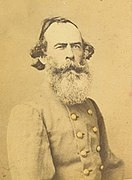| 10th Virginia Cavalry Regiment | |
|---|---|
 Flag of Virginia, 1861 | |
| Active | May 1862 – April 1865 |
| Disbanded | April 1865 |
| Country | |
| Branch | |
| Type | Cavalry |
| Size | Regiment |
| Engagements | American Civil War |
| Commanders | |
| Notable commanders | Col. Robert A. Caskie Col. William B. Clement Col. J. Lucius Davis |
The 10th Virginia Cavalry Regiment was a cavalry regiment raised in Virginia for service in the Confederate States Army during the American Civil War. It fought mostly with the Army of Northern Virginia.





